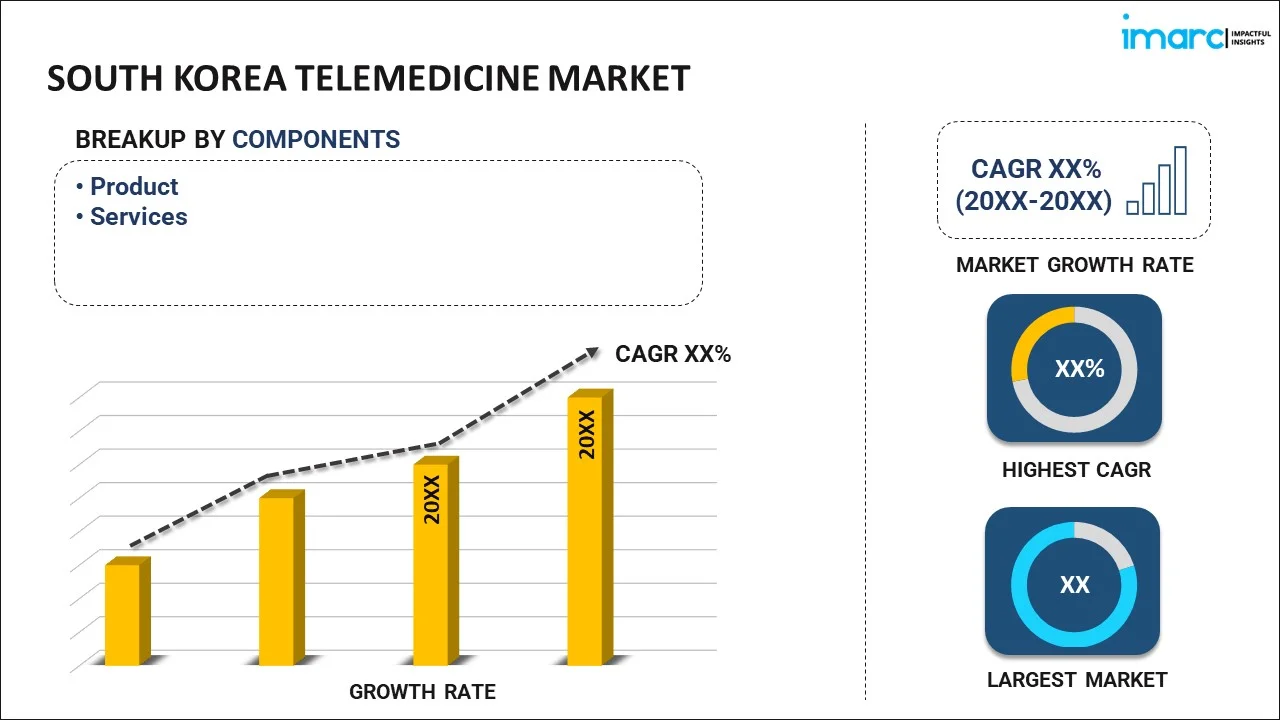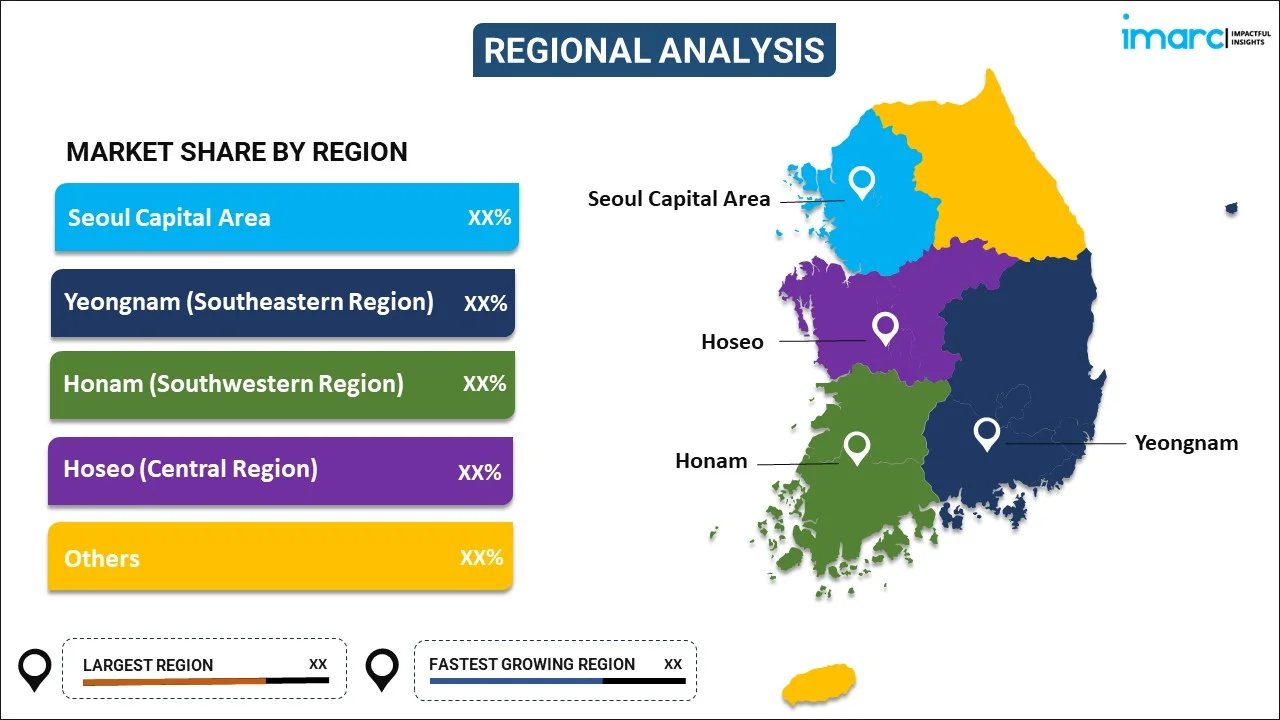
South Korea Telemedicine Market Report by Component (Product, Services), Modality (Real-time, Store and Forward, and Others), Delivery Mode (Web/Mobile, Call Centers), Facility (Tele-Hospital, Tele-Home), Application (Teledermatology, Teleradiology, Telepsychiatry, Telepathology, Telecardiology, and Others), End User (Providers, Payers, Patients, and Others), and Region 2025-2033
Market Overview:
South Korea telemedicine market size reached USD 1,744.4 Million in 2024. Looking forward, IMARC Group expects the market to reach USD 5,027.2 Million by 2033, exhibiting a growth rate (CAGR) of 12.48% during 2025-2033. The growing need for offering a transformative solution to healthcare delivery by ensuring broader accessibility, convenience, and efficiency for patients across the nation is primarily driving the market growth across the country.
|
Report Attribute
|
Key Statistics
|
|---|---|
|
Base Year
|
2024 |
|
Forecast Years
|
2025-2033
|
|
Historical Years
|
2019-2024
|
| Market Size in 2024 | USD 1,744.4 Million |
| Market Forecast in 2033 | USD 5,027.2 Million |
| Market Growth Rate (2025-2033) | 12.48% |
Telemedicine is a healthcare methodology that utilizes telecommunications technology to deliver medical services and consultations remotely. This involves patients connecting with healthcare professionals through virtual means, including video calls, phone calls, or secure messaging platforms. The advantages of this approach include improved access to medical expertise, especially for individuals in remote or underserved areas, along with reduced travel time and costs. It enhances convenience for both patients and healthcare providers. Telemedicine covers a broad spectrum of healthcare services, ranging from diagnosis and treatment to monitoring chronic conditions, prescription refills, and mental health support. Its global recognition has surged in recent years, primarily owing to its capacity to offer prompt healthcare access, especially during emergencies and public health crises such as the COVID-19 pandemic.
South Korea Telemedicine Market Trends:
The South Korea telemedicine market stands as a progressive and integral component of the nation's healthcare landscape, leveraging telecommunications technology to redefine healthcare accessibility. A notable advantage of the South Korea telemedicine market is its ability to bridge geographical gaps, offering improved access to medical expertise for individuals in remote or underserved areas. Additionally, this proves especially significant in a country characterized by diverse landscapes and population distribution. The telemedicine approach reduces travel time and costs, presenting enhanced convenience for both patients and healthcare providers. Besides this, the scope of telemedicine services in South Korea encompasses a wide array of healthcare aspects, including diagnosis, treatment, monitoring of chronic conditions, prescription refills, and mental health support. The market's prominence has further heightened due to its ability to provide timely healthcare access, a critical factor during emergencies and public health crises, as evidenced by its increased utilization during the COVID-19 pandemic. Apart from this, with South Korea's commitment to technological advancement and healthcare innovation, the telemedicine market is poised for continued growth over the forecasted period.
South Korea Telemedicine Market Segmentation:
IMARC Group provides an analysis of the key trends in each segment of the market, along with forecasts at the country level for 2025-2033. Our report has categorized the market based on component, modality, delivery mode, facility, application, and end user.
Component Insights:

- Product
- Hardware
- Software
- Others
- Services
- Tele-Consulting
- Tele-Monitoring
- Tele-Education
The report has provided a detailed breakup and analysis of the market based on the component. This includes product (hardware, software, and others) and services (tele-consulting, tele-monitoring, and tele-education).
Modality Insights:
- Real-Time
- Store and Forward
- Others
A detailed breakup and analysis of the market based on modality have also been provided in the report. This includes real-time, store and forward, and others.
Delivery Mode Insights:
- Web/Mobile
- Audio/Text-based
- Visualized
- Call Centers
The report has provided a detailed breakup and analysis of the market based on the delivery mode. This includes web/mobile (audio/text-based and visualized) and call centers.
Facility Insights:
- Tele-Hospital
- Tele-Home
A detailed breakup and analysis of the market based on facility have also been provided in the report. This includes tele-hospital and tele-home.
Application Insights:
- Teledermatology
- Teleradiology
- Telepsychiatry
- Telepathology
- Telecardiology
- Others
The report has provided a detailed breakup and analysis of the market based on the application. This includes teledermatology, teleradiology, telepsychiatry, telepathology, telecardiology, and others.
End User Insights:
- Providers
- Payers
- Patients
- Others
A detailed breakup and analysis of the market based on end user have also been provided in the report. This includes providers, payers, patients, and others.
Regional Insights:

- Seoul Capital Area
- Yeongnam (Southeastern Region)
- Honam (Southwestern Region)
- Hoseo (Central Region)
- Others
The report has also provided a comprehensive analysis of all the major regional markets, which include Seoul Capital Area, Yeongnam (Southeastern Region), Honam (Southwestern Region), Hoseo (Central Region), and Others.
Competitive Landscape:
The market research report has also provided a comprehensive analysis of the competitive landscape in the market. Competitive analysis such as market structure, key player positioning, top winning strategies, competitive dashboard, and company evaluation quadrant has been covered in the report. Also, detailed profiles of all major companies have been provided.
South Korea Telemedicine Market Report Coverage:
| Report Features | Details |
|---|---|
| Base Year of the Analysis | 2024 |
| Historical Period | 2019-2024 |
| Forecast Period | 2025-2033 |
| Units | Million USD |
| Scope of the Report | Exploration of Historical Trends and Market Outlook, Industry Catalysts and Challenges, Segment-Wise Historical and Future Market Assessment:
|
| Components Covered |
|
| Modalities Covered | Real-time, Store and Forward, Others |
| Delivery Modes Covered |
|
| Facilities Covered | Tele-hospital, Tele-home |
| Applications Covered | Teledermatology, Teleradiology, Telepsychiatry, Telepathology, Telecardiology, Others |
| End Users Covered | Providers, Payers, Patients, Others |
| Regions Covered | Seoul Capital Area, Yeongnam (Southeastern Region), Honam (Southwestern Region), Hoseo (Central Region), Others |
| Customization Scope | 10% Free Customization |
| Post-Sale Analyst Support | 10-12 Weeks |
| Delivery Format | PDF and Excel through Email (We can also provide the editable version of the report in PPT/Word format on special request) |
Key Questions Answered in This Report:
- How has the South Korea telemedicine market performed so far and how will it perform in the coming years?
- What is the breakup of the South Korea telemedicine market on the basis of component?
- What is the breakup of the South Korea telemedicine market on the basis of modality?
- What is the breakup of the South Korea telemedicine market on the basis of delivery mode?
- What is the breakup of the South Korea telemedicine market on the basis of facility?
- What is the breakup of the South Korea telemedicine market on the basis of application?
- What is the breakup of the South Korea telemedicine market on the basis of end user?
- What are the various stages in the value chain of the South Korea telemedicine market?
- What are the key driving factors and challenges in the South Korea telemedicine?
- What is the structure of the South Korea telemedicine market and who are the key players?
- What is the degree of competition in the South Korea telemedicine market?
Key Benefits for Stakeholders:
- IMARC’s industry report offers a comprehensive quantitative analysis of various market segments, historical and current market trends, market forecasts, and dynamics of the South Korea telemedicine market from 2019-2033.
- The research report provides the latest information on the market drivers, challenges, and opportunities in the South Korea telemedicine market.
- Porter's five forces analysis assist stakeholders in assessing the impact of new entrants, competitive rivalry, supplier power, buyer power, and the threat of substitution. It helps stakeholders to analyze the level of competition within the South Korea telemedicine industry and its attractiveness.
- Competitive landscape allows stakeholders to understand their competitive environment and provides an insight into the current positions of key players in the market.
Need more help?
- Speak to our experienced analysts for insights on the current market scenarios.
- Include additional segments and countries to customize the report as per your requirement.
- Gain an unparalleled competitive advantage in your domain by understanding how to utilize the report and positively impacting your operations and revenue.
- For further assistance, please connect with our analysts.
 Request Customization
Request Customization
 Speak to an Analyst
Speak to an Analyst
 Request Brochure
Request Brochure
 Inquire Before Buying
Inquire Before Buying




.webp)




.webp)












